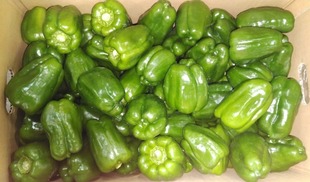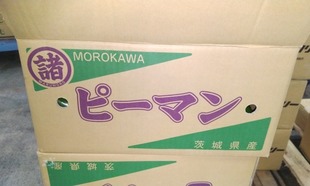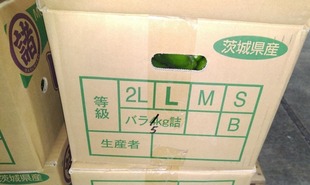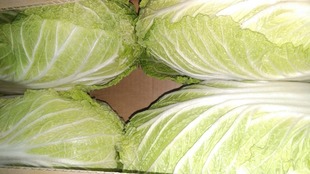【Product name】
Morokawa green pepper
Capsicum annuum L. ‘Grossum’ group
Ibaraki Prefecture has the largest acreage and production volume in Japan. More than 90% is cultivated in the Rokko area, boasting the largest cultivation area and production volume in Japan. Recommended for barbecue in the coming season as oil improves the absorption of nutrients in peppers. Ibaraki Green peppers, which pursue “safety, security, and freshness” through a cultivation method that takes quality and the environment into consideration, are characterized by their deep color, gloss, soft meat, and less bitterness. Bell pepper is a plant of the Solanaceae family native to tropical America. The name comes from French (piment), and in English it is called bell pepper, and the green one is called green pepper. As the name suggests, peppers are a member of pepper, but they are not spicy because they contain almost no capsaicin, which is a spicy ingredient. In the past, it seemed that many people were not good at the unique green odor, but recently, breeding has progressed, and varieties with less loss are being born. “Koga City, Ibaraki Prefecture”, It is located in the center of the Kanto Plain, at the western end of the prefecture. Saitama on the west side, Tochigi on the north side, Yuki City on the east side, Yachiyo Town. The south side is in contact with Goka, Sakai, and Bando. The terrain is flat over almost the entire area, and the climate is generally warm. The climate is also generally warm: In natural conditions blessed as a place of living and production. Area 123.58 km2 : Geographical conditions-Also, the distance to Tokyo, Saitama City and Utsunomiya City is 50-60 km. Including JR Utsunomiya Line, the transportation network of Japan National Route 4 and New Japan National Route 4 etc. has been improved. In addition, exchanges with Saitama New Urban Center, Oyama, and Utsunomiya are active. In recent years, population, housing, and industrialization have been concentrated. “古河”は, 古く“許我"と表記. The scene of that time is described in the Manyoshu. It was already crowded as a ferry port for the Watarasegawa River from the Nara Period. ‘万葉集 / 巻十四, 東歌’ - 逢(あ)はずして 行かば惜しけむ 真久良我 (まくらが) の 許我 (こが) 漕ぐ船に 君も逢はぬかも; お会いしないままで 出かけてはとても残念だな. 真久良我の許我を漕ぐ舟の上の貴方にお会いできたらいいのにな.(3558), 真久良我の 許我の渡(わたり)の 韓楫; 可良加治 (舵; からかぢ) の 音高 (おとだか) しもな 寝(ね)なへ児ゆゑ(ヱ)に; 真久良我の 許我の渡しの韓楫(梶)の音が高いように 噂が高く立ったな. 未だ共寝をした娘ではないのにな(3555). Koga Village, Expression of one's feelings-It shows that it is a land of rich culture centered on the river. The army of calligraphers is a calligrapher-故, 大久保翠洞(Suido Okubo-Mainichi (literally, everyday), Founder of the “Engraving” department. 1906-1997). “Tone River monument” - まくらがの 許我の渡りのからかじの音高しもな寝なへ児ゆえに; まくらがの許我の渡し場に響く韓梶の音のように噂が高いね. 一緒に添寝もしない子なのに, 逢はずして行かば惜しけむまくらがの許我こぐ船に君も逢はぬかも; 逢わずに行くのは残念だよ. まくらがの許我を漕ぐ舟であなたにひょっこり逢えないものか. The other monument stands on the Watarase sword beside the Suzume(鎮め)Shrine(宮前町). The army of the book is a seal carving-故, 生井子華(Shika Ikui; 1904-89). Kawatodai Remains(牧野地): There was one of the largest steel making shops in eastern Japan from the beginning of the 9th century to the 10th century; 古河市教育委員会 2012 “川戸台遺跡" 古河市埋蔵文化財調査報告書10, まくらがの里遊歩道建設に伴う牧野地地区埋蔵文化財調査報告書, 種別; 製鉄, 縄文時代, 縄文土器, 土製品, 石器, A large amount of iron-related relics have been excavated. In particular, the amount of excavated mold is 565.981 kg. 獣脚付き鍋や, 把手付き片口鍋等を製作. In addition, letters are engraved on the mold, and when it is inverted, “弥勒”の「勒」, A board-shaped mold that can be read as is excavated. 種別; 製塩, 古墳地代, 竪穴2, 土師器, 円筒埴輪, 石器, 製鉄, 平安時代, 炉4, 工房1, 炭窯1, 粘土採掘坑2, 排滓場4, 柱穴1, 溝4, 路壁, 羽口, 小型専用坩堝, 鋳型, 鉄製品, 土師器, 須恵器, 灰釉陶器, 瓦, かわらけ(土師質土器), 内耳鍋, 製鉄, 中世(細分不明)時代, 溝4, 中世以降. Nagaoki Eguchi kiln remains: A semi-basement type flat kiln was also discovered in the latter half of the 9th century. 毛野考古学研究所他 2011 “江口長沖窯跡” 古河市埋蔵文化財調査報告書5 , 筑西幹線道路整備に伴う江口地区内埋蔵文化財調査報告書. It seems that it was also a production base for iron and ceramics. The home of Koga from the late Muromachi period to the Warring States period. 5th Kamakura kubo (Governor-general)-higeuji Ashikaga(Founder)has moved from Kamakura to Koga. Assassination of Kanto Kanrei, Noritada Uesugi, 享徳の乱; After that, it was handed over to Masauji, Takamoto, Haruuji, and Yoshiuji for about 130 years. Castle town of Koga Castle in the Edo period: Koga-inn(通町; 横町, 1,2丁目, 台町, 原町. 脇町 / 街道東側, 鍛冶町, 新町, 八幡町. 西側; 石町, 江戸町, 大工町. 川沿い; 悪戸新田, 船渡町. 枝町; 紺屋町, 天神町, 田町, 青物町, 七軒町, 肴町, 元肴町, 四谷 / 嵯峨. 屋敷町; 厩町, 白壁町, 仲之町, 鳥見町, 杉並町, 代官町, 三神町, 片町, 六軒町 / 四軒町.), a post town on the Nikko Kaido, flourished. The Koga domain spans Shimousa, Shimotsuke, and Musashi provinces. The city area was also incorporated into Ibaraki Prefecture via Shimousa and Chiba prefectures. Former Hitachi country, formed mainly by Mito Kaido(The roads which ran from Edo to Sendai along the Pacific coast were called “Rikuzenhama-kaido Road,” and among them the one which ran to Mito City, where one of three privileged branches of Tokugawa family was located, was occasionally called): Positioned as a sidestream in the history of Ibaraki Prefecture since modern times.“Nirei / Nire(仁礼; 仁連)” is a place name from the Warring States period. 第4代古河公方 / 足利晴氏 公安堵状写: 若林 / 仁礼両郷. During the Warring States period, it was a royal palace of Koga Kubo. Chigyo Enforcement Letter on September 20, 1590-From Hideyoshi to Harushige Yamakawa(Originally a retainer of the Yuki family-山川綾戸城; 現:結城市山川新宿): 幸島郷之内 二十五貫 仁連. Nirei Town, It was allowed as a post station on the Nikko Higashi Kaido (Nikko Sekiyado Takodo): 江戸時代; 1648年(慶安元年)11月6日-猿島郡郷土大観, 1927: 往昔領主堀江侯なるもの 若林に小城を設けて居住せし... By the way, Nirei also has the upper and lower towns that are often seen in post stations. Kami-cho is located on the north side and Shitamachi is located on the south side. In order from the south-Uemachi, Nakamachi (Nakamachi), Shitamachi in order. Why are Nirei and Morokawa in the opposite order? There's room for improvement. Forgive me because I still lack research. 鷹見泉石(古河藩家老)(公)関係資料(H16, 国指定文化財; 歴史博物館(中央町)) 文書 / 記録類686点, 絵図 / 地図類768点, 書籍類466点, 書状類912点, 絵画 / 器物類321. Morokawa inn is the 7th post station counting from Oiwake between Mito Kaido Kogane inn and Abiko inn , which was the starting point of Nikko Higashi Kaido in the Edo period. “Koryuji Temple (Jishū sect (of Buddhism)) Oan 4th Year Name Plate Monument (City Designated Cultural Property)” -諸川-Built in November 1371 during the Nanbokucho period, the Nijo line and border are clearly engraved, and the principal idols Amida Nyorai (Kiriku) and Rengeza, as well as a delicate canopy on the principal idol. A vase is vividly carved under the lotus position. Height 65.8 cm (on the table), width 25.7 cm, thickness 2.2 cm. “Sanwa Gion Bayashi”, Morokawa castle owner Kanro Shinanokami rebuilt Nagamiya Shrine, and Gion Bayashi appeared at the summer festival held there around 1438. Dedicated with a prayer for a good harvest, disaster control, and extinction of the plague. A long time ago, it was called “Kabasan Bayashi” until the Meiji era because it was also used for festivals at Kabasan Shrine. Hayashi, which has been handed down in this area, was handed down by a Kagura servant living in 東山田五味蔵 (Yonekura) in 1772-80, and is said to have reached the present day. It has been declining since before World War II, and was inherited as a comfort for the elderly until around 1960, but it was revived after the awakening of a young man. Currently, 7 branches (Morokawa, Komagome, 宿, Yonekura, Onna, Setoyashiki, Shimouchi) are active. The “Koga Peach Festival” will be held from late March to early April at the Furukawa Comprehensive Park, which has about 1,500 peaches of five types. The peach forest in the general park is considered to be the best peach forest in Japan. The first event was held in 1977, shortly after the opening of the general park. Peach is characterized by darker flowers than cherry blossoms. “Koga Castle” was located on the left bank of the Watarase River, and now most of the ruins have been lost due to river improvement, leaving only some of the earthworks and moats. It has a long history and was built at the end of the Heian period by the later Gokenin of the Kamakura Shogunate, Yukihira Shimokawabe. The castle at that time and until the time of Koga public affairs in the Muromachi Period is not known in detail, but it is said that it was a natural fortress on a long plateau between the Watarase River on the west side and a swamp on the east side. The castle area in the Edo Period, including the water moat, was approximately 500 m east-west and 2 km north-south, making it one of the largest in the Kanto region. The west side of the castle was the Watarase River, and the other three sides were water moats. In the structure, a plurality of curved rings surrounded by earthen walls were arranged in a straight line, and there were a main circle, a outer citadel, a Sannomaru, and the like. The castle tower was not built, but the tower on the 3rd and 4th floors, which was 22 m high and was built in the northwest corner of the main enclosure, was the actual castle tower. As the only remains of Furukawa Castle, the Inuimon remains as the gate of the Fukuhoji Temple (Otani sect of Shinshu) in Koga City. The Koga Castle Ochayaguchi Monument along the Old Nikko Kaido used Koga Castle as an inn when the third shogun, IEMITSU, visited Nikko. It is said that it is the site of a teahouse established by the castle owner Toshikatsu DOI to entertain it. Since then, it has been a customary place to greet the shogun and the prestigious daimyo, and the other party also comes to greet here(aesthetic sense in Japanese art centered on the acceptance of transience and imperfection; 侘び寂び ≒ WASABI). Since then, it has been a customary place to greet the shogun and the prestigious daimyo, and the other party also comes to greet here. It is said that the other daimyo were treated at the treats bansho in Sakana Town.
Koga City is located in the center of the Kanto region, at the westernmost tip of Ibaraki Prefecture, and is famous for its history and tradition, with nature rich in water and greenery facing the Tone and Watarase rivers. Even now, the city is dotted with many temples and shrines that retain the remnants of castle towns and post towns. In addition, it seems that historical and cultural facilities are concentrated at the west exit of Furukawa Station, such as the Furukawa Historical Museum and the Tenkoku Museum. Hanamomo no Sato, Furukawa Comprehensive Park (also known as Koga Park. Area of about 23ha (maintained). Opened in 1975. About 2000 peach trees are famous. The peach festival is held in spring. There are also Oga lotus (meaning the ancient lotus fruit found at the Kemigawa site in Hanamigawa-ku, Chiba city in 1951) and Ayameen, where you can enjoy seasonal flowers. Furukawa's peaches are in Edo. At the beginning of the era, Toshikatsu Doi, the feudal lord, had the children of Edo's vassals collect peach seeds and sent them to Furukawa in an attempt to enrich the lives of the people as much as possible. It grows in a few years and can be eaten. It is said that the trees can also be used as firewood. After that, around 1764-80, the peaches were replanted, and so It seems that it has become known as a famous place for peaches. It seems that the peaches that were planted at that time were edible varieties such as Hanbei Peach, Kintoki Peach, Tianjin Peach, and Suimitsu Peach. There was a special train from Ueno Station, and there was a dance of Geiko and a horse racing tournament at the venue. During the war, Momobayashi was changed to a field of wheat and land rice to increase food production. Since then, the momentum for revival has increased, and maintenance has started in 1973. In 2003, it was the first in Japan to receive the "3rd Melina Mercuri International Award for the Protection and Management of Cultural Landscapes" sponsored by UNESCO and Greece. This award was established in 1992 to honor outstanding activities aimed at preserving and managing the world's major cultural landscapes. Melina Mercuri (1923-94) is the Minister of Culture of Greece, working to harmonize landscape conservation and sustainable development. Originally active as an actress, she won the Cannes Film Festival Leading Actress Award for "Don't Sunday". The prestigious award was given as a general evaluation that "it was in the suburbs of Tokyo and withstood development pressure", "regeneration of nature and culture by restoration of the disappearing swamp (Gosho-numa)", and "various contacts between nature and humans". The three points of "a design that expresses the nature" and "the activities of the citizens who are familiar with the nature of the four seasons" were highly evaluated.) 1500 peach blossoms of five types are in full bloom, which is pleasing to the eyes of visitors.
Morokawa is also known for the fact that Kazutoyo YAMANOUCHI, a military commander who accompanied Ieyasu Tokugawa's Aizu troops prior to the Battle of Sekigahara, was in the camp in 1600. He received a secret letter from Osaka's wife telling Mitsunari Ishida's troops there, and told Ieyasu, who was currently in Oyama City, Tochigi Prefecture, to get a clue to his standing. Furthermore, Morokawa was developed by the Edo Shogunate as a post town on the side road "Nikko East Highway" of Nikko Toshogu Shrine, and many old townscapes such as the brewery of the soy sauce brewer still remain.
Morokawa is the old post town of Nikko East Return (7th counting from the Mito Kaido branch). Nikko East Return is a government road that branches between Kogane inn and Abiko inn on the Mito Kaido, northeast of Mukai Kogane, passes through castle towns such as Sekijuku and Yuki, and joins the Nikko Kaido between Ishibashi-juku and Jakumiya-juku on the Nikko Kaido. It seems to be new. In addition to the purpose of visiting the Nikko Shasan of the shogun family, it seems that it was also used for the change of attendance of the surrounding daimyo, the transportation of goods, and the common people. The range of the post station seems to be the southern end of the Morokawa crossroads between the current national highway No. 125 and the prefectural highway No. 17 (former Nikko East Return), and the northern end near the Morokawa post office. From the south, it consists of Uemachi, Nakamachi, Shitamachi, and Shinmachi along the Shimotsuma Road, which branches to the east on the way. It can still be recognized as an excellent historical townscape because of the appearance of the Ohashi soy sauce shop's mansion and brewery near the northern end, and there are other brewery and girder-style townhouses left.






0 件のコメント:
コメントを投稿